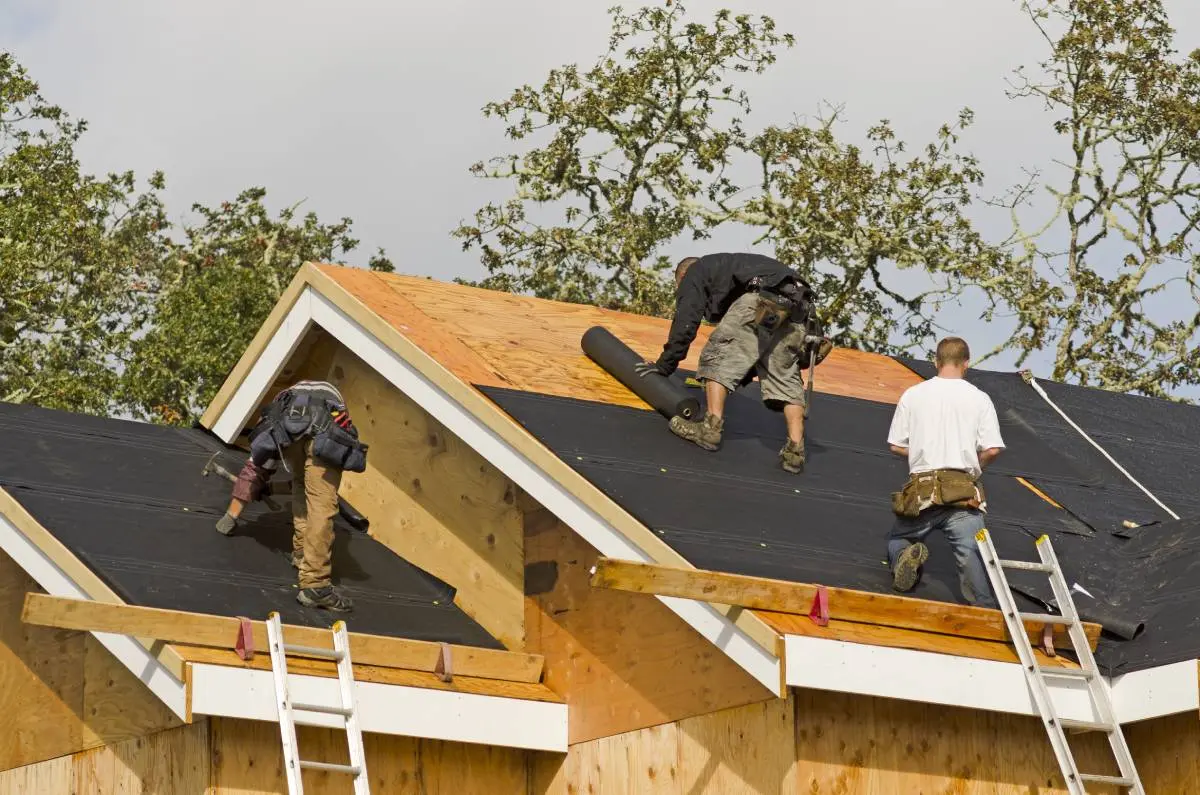According to Spherical Insights, the U.S. roofing market was worth $27.5 billion in 2023 and is on pace to hit $42.7 billion by 2033, expanding at a CAGR of roughly 4.5%. Rising demand from aging homes, extreme weather conditions, and evolving building codes means there’s a consistent need for professional roofers, reflecting the ongoing trends in the roofing industry.
Starting a roofing company can be one of the most profitable moves in the construction industry, but it’s not enough to know how to install shingles or repair leaks. Running a successful roofing business also requires navigating permits, insurance, equipment investments, labor management, and client acquisition.

Whether starting from scratch or transitioning from contractor to business owner, this guide breaks down everything you need to know about how to start a roofing company and grow it sustainably.
Create a Business Plan
A well-structured business plan is your blueprint for success. It should outline services, target market, operating costs, and marketing strategy, among other foundational elements.
Define Your Services
Starting a roofing company isn’t a one-size-fits-all endeavor. Your specific services shape everything from your pricing and tools to your marketing strategy and insurance needs. Here are the main categories of roofing services you can offer:
By Property Type
- Residential Roofing: Includes replacements, roof remodeling, maintenance, and inspections for single-family homes. Asphalt shingles are the most common, but you might also offer tile, slate, or metal roofing.
- Commercial Roofing: Involves flat or low-slope roofs on offices, warehouses, and retail properties. Materials include EPDM, TPO, and modified bitumen. These jobs are more complex but also more profitable.
By Project Scope
- New Roof Installations: Requires precise coordination with other contractors and tends to be more labor-intensive work. These projects are common in new constructions or major roof renovations.
- Roof Repairs and Maintenance: Includes emergency repairs, seasonal maintenance, and leak inspections. These smaller jobs are consistently in demand and help keep your calendar full.
By Specialized Offering
- Specialty Services: Consider if you’ll offer skylight installation, roof ventilation, gutter systems, roof coatings, solar panel integration, or eco-friendly options. These can help set your business apart in a crowded market.
Study the Local Market
You can’t build a successful roofing business without knowing your customer base.
Start by researching your local area. What types of properties are common? Are most roofs pitched or flat? Do people use asphalt shingles, tile, or metal? What weather conditions — snow, rain, or wind — affect roofs in your region?
Next, evaluate your competition. How many roofing businesses are operating nearby? What services do they offer? What do their reviews say? Are they booked out or advertising next-day availability?

After researching your local roofing market and competition, determine your business’s unique value proposition. Can you offer faster service, better customer care, or more competitive pricing? Is there a market for specialized services like solar integration or eco-friendly materials?
Use this research to strategically position your company. You may become the go-to roofer for emergency repairs or the first in your area to offer drone inspections. Tailoring your services to fit local demand will help set you apart.
Outline Your Startup and Operating Costs
If you’re learning how to start a roofing company, you need an understanding of your startup costs to set sustainable prices. Planning ahead helps ensure you won’t burn through capital before landing your first major job. Here are the main expenses you need to budget for when starting a roofing company:
- Business Registration and Legal Fees: Basic state filing fees range from $100 to $500. Forming a limited liability company (LLC) or corporation may bring total costs to around $1,000 to $3,000, especially if you hire a lawyer.
- Licensing and Permits: Costs vary depending on your state. Expect to pay anywhere from $100 to $5,000, depending on your location and requirements.
- Insurance: Required in most states, insurance premiums can cost several thousand dollars annually.
- Tools and Equipment: Initially, you should expect to spend around $10,000 when building out your supply of roofing tools and equipment.
- Work Truck or Van: A reliable vehicle is another significant expense, often costing around $25,000 to $35,000 for a used model in good condition. Look for one with storage options to help you transport tools and materials efficiently.
- Marketing and Branding: You should consider setting aside $5,000 to $10,000 for marketing and branding materials, including your website, logo, and basic ads.
In the following sections, we’ll dive deeper into these operating costs to help you plan your budget confidently.
Set Your Pricing Strategy
The pricing for your services should cover your costs, pay your team fairly, and generate a profit. Before starting a roofing company, here are three common pricing models to consider:
- Per Square Foot: This is the most common model. The average cost of a new roof ranges from $4 to $12 per square foot, depending on materials, complexity, and location. For example, asphalt shingles cost $3 to $6 per installed square foot, while metal or tile roofing can reach up to $16.
- Per Square (100 Sq. Ft.): Some contractors quote prices per roofing square. A typical roof replacement with asphalt shingles can cost between $300 and $600 per square. Metal roofing can range from $500 to $1,600 per square.
- Flat Rate Per Project: Smaller repairs or simple jobs are often billed as a flat fee. For example, a roof leak repair may cost anywhere from $150 to $1,000, depending on the severity and location.
A healthy profit margin in the roofing industry is usually between 20% and 40%. To avoid underpricing, you need to calculate how much it costs you to complete a job:
- Material Costs: Include shingles, underlayment, flashing, nails, sealants, and waste disposal.
- Labor Costs: Factor in employee wages or subcontractor fees.
- Fuel and Travel: Adjust your rate to reflect the cost of transportation.
- Permits and Inspections: Consider the underlying cost of city permits or certified inspections, depending on location.
- Warranty or Follow-Up Service: Build any follow-up service or guarantees into your price.
By understanding your costs and selecting the right pricing model, you can set roofing service pricing that is competitive, sustainable, and profitable for your business.
Get the Licenses You Need to Start a Roofing Company
Operating without the proper licenses and insurance can result in fines, project delays, or worse — risks you can’t afford when learning how to start a roofing company.
The requirements for a roofing license vary by state. For example, in some states, you need a roofing-specific license. In others, a general contractor license covers roofing work. Some states don’t require licensing, though many cities and counties still do. Here are some state-specific examples:
In Florida, you need a Florida roofing license from the Department of Business and Professional Regulations (DBPR) via the Construction Industry Licensing Board (CILB). Application fees range from $149 to $249, depending on the time of the year.
In Texas, there is no state-level roofing license, but many cities require contractors to register locally, which typically costs around $150 a year.
In California, you need a C-39 Roofing Contractor License from the Contractors State License Board. The cost includes a $450 application fee, a $200 initial license fee, and additional charges for the exam and fingerprinting.
In Illinois, roofing contractors must obtain a license through the Department of Financial and Professional Regulation. You’ll need to pay a $125 application fee, a $248 exam fee, and a $62.50 annual renewal fee. The state offers separate licenses for residential, commercial, or both.

Even in areas where a roofing license isn’t needed, you’ll likely need:
- A business license to operate legally in your local area, which can cost $50 to $400, depending on your city or county.
- An Employer Identification Number (EIN) to hire employees and file taxes under your business name. You can get one for free through the IRS website.
- A DBA (Doing Business As) or Trade Name Registration if your business name differs from your personal name or LLC. Registration costs $100 to $150, depending on the state.
- A general liability insurance policy to cover third-party damage or injury caused by your work.
- Workers’ compensation insurance to protect employees in case of injury on the job, required in most states.
- A surety bond to have as a guarantee of ethical and financial responsibility, as necessary by municipality or state regulations.
Get the Necessary Roofing Equipment
You can’t run a roofing business without the right tools to help you work safely and deliver high-quality results.
Basic Tools and Gear
Let’s start with the must-haves for almost every roofing job that you can find at hardware stores or supply centers.
- A roofing nail gun helps speed up shingle installation and provides consistent results across the roof. This can cost between $217 and $479.
- An air compressor powers your pneumatic tools, including your nail gun. This typically costs around $149.
- A roofing shovel or a tear-off tool aids in removing shingles or other roofing materials during demolition. Prices range from $50 to $115.
- A circular or reciprocating saw is used for cutting, flashing, or trimming on the job site. Expect to pay anywhere between $100 and $200.
- Utility knives and blades can cut underlayment, shingles, and flashing. These are typically around $32 each.
- Tape measurements and chalk lines help with accurate measurements and layout work on every roof. These can cost between $5 and $35 each.
- Roof brackets and toe boards support safe footing when you work on steep-sloped roofs. They range from $12 to $50 each.
- A 32-foot extension ladder is a must for most residential roofing jobs. A sturdy ladder typically costs between $200 and $500.
- A magnetic sweeper cleans up nails and metal debris around the site after completing a project. This can cost between $100 and $200.
Safety Equipment
As anyone starting a roofing company knows, it is physically demanding work with real safety risks. Investing in the following safety equipment is not optional; it’s necessary.
- Hard hats, gloves, and safety glasses usually range from $10 to $40. Be sure to keep extra sets of basic safety gear on hand for your crew.
- Work boots with a solid grip can cost between $100 and $200. Choose a slip-resistant pair comfortable enough for long hours on pitched surfaces.
- A full-body safety harness ranges from $100 to $250 and helps prevent falls while meeting OSHA safety standards.
- Roof anchor kits typically cost between $50 and $150. They’re used to attach safety harnesses securely to the roof structure.
- Ropes, lanyards, and lifelines range from $100 to $300 and can be used to create a complete fall arrest system.
Truck or Van
A reliable vehicle is one of your most significant investments. A used work truck or cargo van typically costs between $25,000 and $35,000. You’ll need it to haul ladders, tools, and sometimes materials. So, look for one with solid storage options and rack systems.
Job Site Essentials
To ensure your job runs smoothly, consider investing in these small but important items:
- A durable tool belt to keep your most-used tools within reach usually costs between $30 and $80.
- Coolers or water dispensers help keep your crew hydrated during long, hot days on the job. Prices can range from $30 to $100.
- Portable tarps protect roofs, siding, and landscaping during tear-offs or unexpected rain. They typically cost between $20 and $100.
Hire Your Crew and Contractors
Even the best business plan and top-quality tools won’t get you far without a solid team. Roofing is physically demanding, deadline-driven, and requires high-level skills. A reliable crew can help you build a strong reputation, while the wrong hires can cost you time, money, and client trust.
Start Small and Build as You Grow
Initially, many roofing business owners may choose to handle most of the work themselves. As your workload increases, you may need help to take on multiple jobs or larger projects. You can hire employees or enlist subcontractors.
Employees will be on your payroll. You’re responsible for their wages, taxes, and benefits. Hiring them gives you more control, but comes with added responsibilities.

Subcontractors are independent workers or small crews you pay per job. You don’t handle their taxes or other employer responsibilities, but you have less control. Subcontracting is more flexible, but make sure you only work with licensed, insured, and dependable professionals.
Many roofing businesses use a mix of both, hiring employees for core work and subcontractors for overflow or specialty jobs. If you choose to work with them, subcontractors typically charge between $200 and $1,700 per square (100 sq. ft.), depending on the job’s scope, complexity, materials, and local labor market.
Key Roles to Consider
As your business grows, you want to fill the following positions to support your growth.
Roofing installers, the core of your crew, typically earn between $16 and $33 per hour, depending on their experience and your region. Look for roofers skilled in your preferred materials and committed to safely delivering high-quality work.
Project managers or crew leaders earn around $25 to $50 per hour and are responsible for overseeing job progress, managing timelines, and staying in contact with clients. This role can be especially important when handling multiple projects at once.
Estimators or sales representatives, whose pay can vary based on commission or salary, help you quote jobs, follow up with leads, and close deals so you can stay focused on operations. Typically, this position earns around $40 per hour.
Office assistants or virtual admins may cost $300 to $1,000 per month, depending on hours and responsibility. They can manage scheduling, invoicing, supply orders, and customer communication, taking repetitive tasks off your plate.
Market and Scale Your Roofing Business
With your licenses, equipment, and team in place, the next step is to make sure your potential customers know you exist. Below are some tried-and-true marketing techniques for roofing businesses.
Build a Strong Online Presence
Many homeowners search for roofers online. If they can’t find you, they’ll find someone else.
Start with your website. You can build a company website using platforms like Wix or Squarespace for around $13 to $40 per month. A custom domain name usually adds another $15 to $60 per year. If you’d rather hire a professional developer, expect to pay between $2,500 and $10,000, depending on site complexity and desired features.
Next, set up your Google Business profile, which is free. This listing shows your business on Google Maps and in search results. Include your business hours, contact details, and service areas. Upload recent job photos and encourage clients to leave reviews.
Lastly, utilize social media platforms to reach local homeowners. Post photos of your work and valuable content, like tips and tricks. Setting up your social media accounts is free, but expect to spend $100 to $500 for boosted posts or ads.
Invest in Local Advertising
With targeted advertising, you can reach local homeowners when they need a roofer, especially during home improvement season or after storms.
Depending on your location and competition, you can expect to pay anywhere from $300 to $1,500 for Google Ads or Local Service Ads to generate leads. In high-demand areas, the cost per click can fall between $10 and $30, so track your performance and adjust your strategy as needed.
You can also follow the traditional route and make door hangers and yard signs. These cost around $200 to $800 to design, print, and distribute. These work well, especially in neighborhoods you’re already working in, where residents can see your crew actively working.
Another old-fashioned method is a referral incentive program. A small reward — gift card, discount, or cash bonus — can encourage satisfied customers to send new business your way.
Offer Financing
Consider offering point-of-sale roofing financing options to make your services accessible to more homeowners. This can improve your close rate, especially for high-ticket projects like full roof replacements or solar integrations.
Track Your Leads
Invest in customer relationship management (CRM) software to track your leads and stay organized. Platforms like JobNimbus, AccuLynx, or Builder Prime help you track leads, schedule jobs, and follow up with customers. This software typically costs $50 to $100 per month.
Consider looking into estimating software tools like RoofSnap or Hover. These let you generate accurate quotes using satellite imagery or photos and usually range from $30 to $150 per month.
Finally, you may also need accounting software to help track expenses, send invoices, and manage payroll. QuickBooks, Xero, and FreshBooks are reputable platforms that cost around $20 to $70 per month.
Prepare to Scale Your Operations
As your job volume increases, consider hiring more crew members. Beyond labor costs, budget for onboarding, training, and uniforms. Add crew gradually and confirm your calendar can support the additional labor.
You may also want to expand your services and open new revenue streams. For example, you may start offering gutter or siding installation.
Lastly, you can grow your marketing efforts by increasing your budget by 10% or 20% as you scale to reach more clients sustainably.
Conclusion
The basics of how to start a roofing company require careful planning and smart decisions from day one. Start where you are, invest wisely, price services strategically, and treat every customer like they’re your first referral.
You don’t need to grow fast. You need to grow right.


